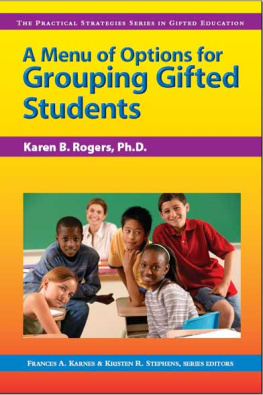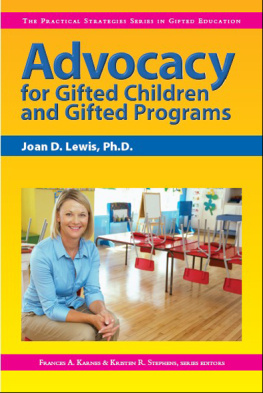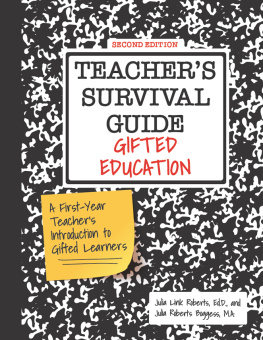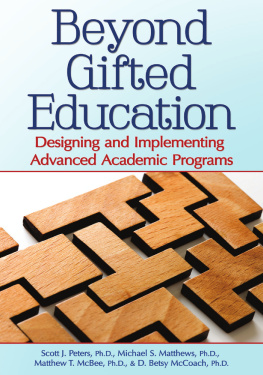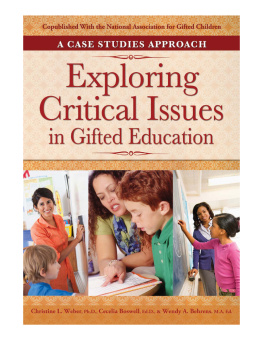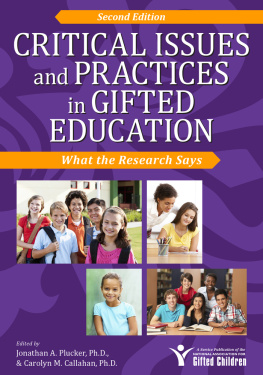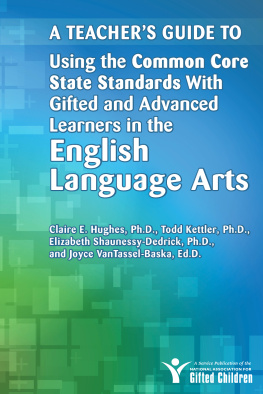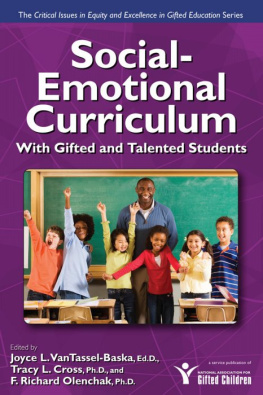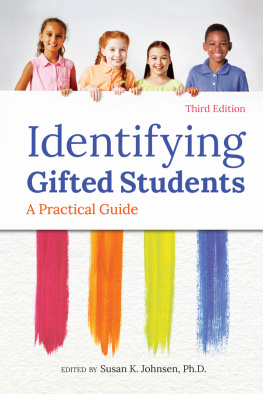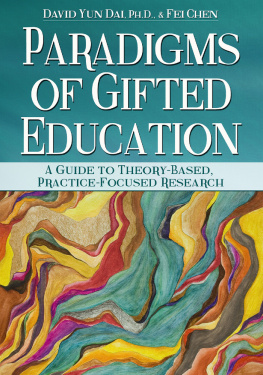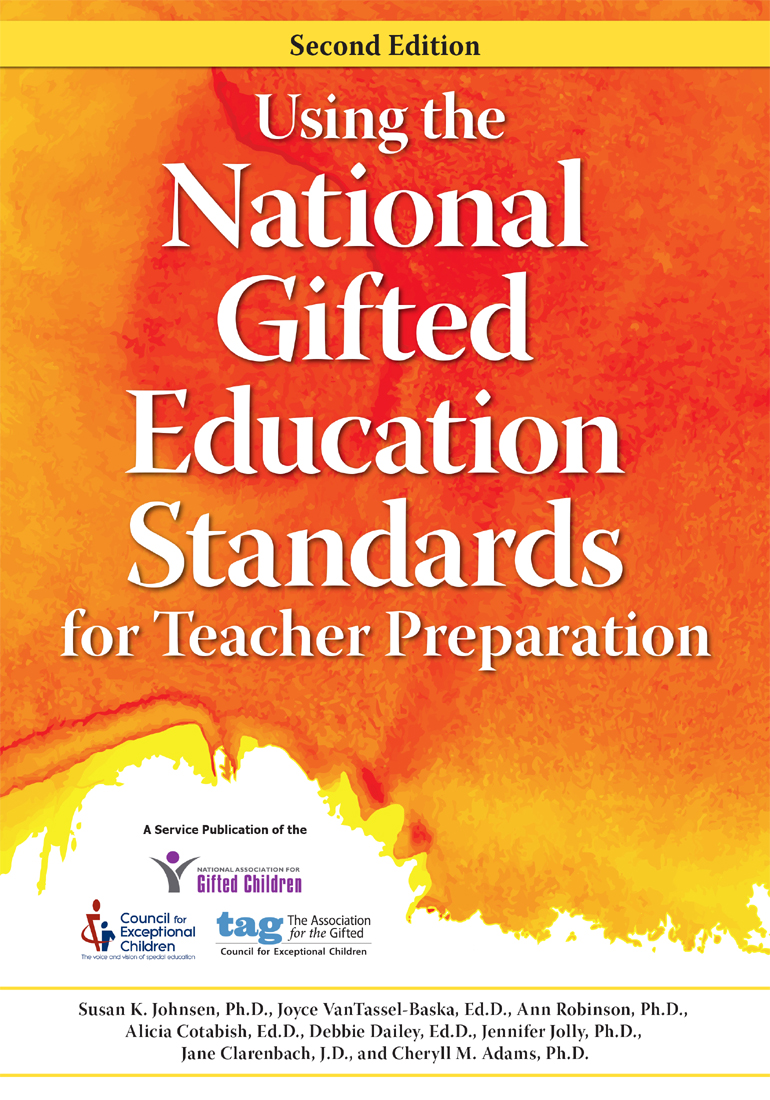


Copyright 2016, National Association for Gifted Children and The Association for the Gifted, Council for Exceptional Children
Edited by Lacy Compton
Cover and layout design by Raquel Trevino
ISBN-13: 978-1-61821-478-2
No part of this book may be reproduced, translated, stored in a retrieval system, or transmitted, in any form or by any means, electronic, mechanical, photocopying, microfilming, recording, or otherwise, without written permission from the publisher.
At the time of this books publication, all facts and figures cited are the most current available. All telephone numbers, addresses, and websites URLs are accurate and active. All publications, organizations, websites, and other resources exist as described in the book, and all have been verified. The authors and Prufrock Press Inc. make no warranty or guarantee concerning the information and materials given out by organizations or content found at websites, and we are not responsible for any changes that occur after this books publication. If you find an error, please contact Prufrock Press Inc.

| Prufrock Press Inc.
P.O. Box 8813
Waco, TX 76714-8813
Phone: (800) 998-2208
Fax: (800) 240-0333
http://www.prufrock.com |
Table of Contents
Introduction and Background
Susan K. Johnsen and Joyce VanTassel-Baska |
Developing Partnerships
Alicia Cotabish and Debbie Dailey |
Integrating Gifted Education Standards Into Education Preparation Providers Programs
Debbie Dailey and Alicia Cotabish |
Developing Courses That Incorporate the National Teacher Preparation Standards in Gifted Education
Ann Robinson and Jennifer L. Jolly |
Preparation of the Specialized Professional Association (SPA) Report for National Recognition
Susan K. Johnsen, Joyce VanTassel-Baska, and Jane Clarenbach |
Advanced Standards in Gifted Education
Cheryll Adams |
Challenges
Joyce VanTassel-Baska, Ann Robinson, Alicia Cotabish, and Susan K. Johnsen |
Foreword
I nformed standards are the foundation of quality teacher preparation programs. Standards define the destination, suggest routes, and provide landmarks to creating programs that graduate effective gifted education teachers who then positively influence our high-ability students. The Council for the Accreditation of Educator Preparation (CAEP) views the NAGC-CEC Teacher Preparation Standards in Gifted Education as the benchmark of excellence.
This guidebook provides the map to using the NAGC-CEC standards to build an effective teacher preparation program, including information on providing quality clinical experiences and measuring the outcomes of those experiences. You will find information on how the 2006 and 2013 teacher preparation standards differ and the research base used in creating the standards. The guidebook was written by teacher educators who are among the best in the field of gifted education.
There are two important new sections in this updated guide. One addresses creating partnerships with K12 schools, parents, and the community at large. Gifted education is a collaborative effort, and providers need to be strategic in sharing the value of and the specifics of effective gifted education strategies. The other new section discusses how to work with our general education colleagues to incorporate gifted education into general education teacher preparation courses. This is crucially important considering the general education teacher is typically the gateway to gifted education assessments and services or, in many cases, is the primary provider of advanced coursework.
Finally, information is provided on preparing a program report for CAEP program review. This section includes examples of quality elements, as well as areas of concern that can assist programs as they apply to become nationally recognized.
We are seeing increased attention to the connection between developing high levels of giftedness and talent in all student populations and the success of the nation. This guidebook will assist schools and districts in supporting that talent development by graduating superior gifted educators.
George Betts
NAGC President
20152017
Acknowledgments
A lthough the authors are responsible for the content, this book incorporates the 2013 teacher preparation standards and builds on the previous guidebook that resulted from the combined efforts of numerous colleagues who contributed to the standards development and their application to higher education settings. Of particular note is Jane Clarenbach at the National Association for Gifted Children (NAGC) who provides ongoing assistance to universities seeking national recognition; Cheryll Adams, chair of the NAGC Professional Standards Committee and representative from The Association for the Gifted on the Council for Exceptional Childrens Knowledge and Skills Subcommittee; the boards of the National Association for Gifted Children and The Association for the Gifted; and the authors of the first guidebookSusan K. Johnsen, Joyce VanTassel-Baska, and Ann Robinson. We also want to thank Lacy Compton, Prufrock Press, for her fine editorial work on this guidebook. We especially appreciate faculty from higher education institutions who so generously contributed examples of coursework and assessments and who believe that these teacher preparation standards will improve the quality of gifted education for Pre-K12 students.
Chapter 1
Introduction and Background
SUSAN K. JOHNSEN AND JOYCE VANTASSEL-BASKA
Introduction
S ince the national teacher preparation standards in gifted education were first released in 2006, two important events have occurred in the area of standards development. First, the National Council for Accreditation of Teacher Educations (NCATE) Specialty Areas Studies Board (SASB; 2004) developed guidelines recommending that Specialized Professional Associations (SPAs; i.e., teaching specialty areas such as social studies, gifted education, science, special education) reduce the number of their teacher preparation standards to 7 and the number of elements to 28 to facilitate both the preparation of program reports and the review process. Second, the Interstate Teacher Assessment and Support Consortium (InTASC, 2013) released the Model Core Teaching Standards as a resource for states, districts, professional organizations, teacher education programs, teachers, and others as they develop policies and programs to prepare, license, support, evaluate, and reward todays teachers (p. 5). These two events precipitated a review by the National Association for Gifted Children (NAGC) and the Council for Exceptional Children (CEC) of the Teacher Preparation Standards in Gifted and Talented Education (2013 Teacher Preparation Standards) and a consequent revision to realign the 2006 Teacher Preparation Standards in Gifted and Talented Education (2006 Teacher Preparation Standards) with the new guidelines and InTASC standards (for the complete development process, see pages 613).
Next page

